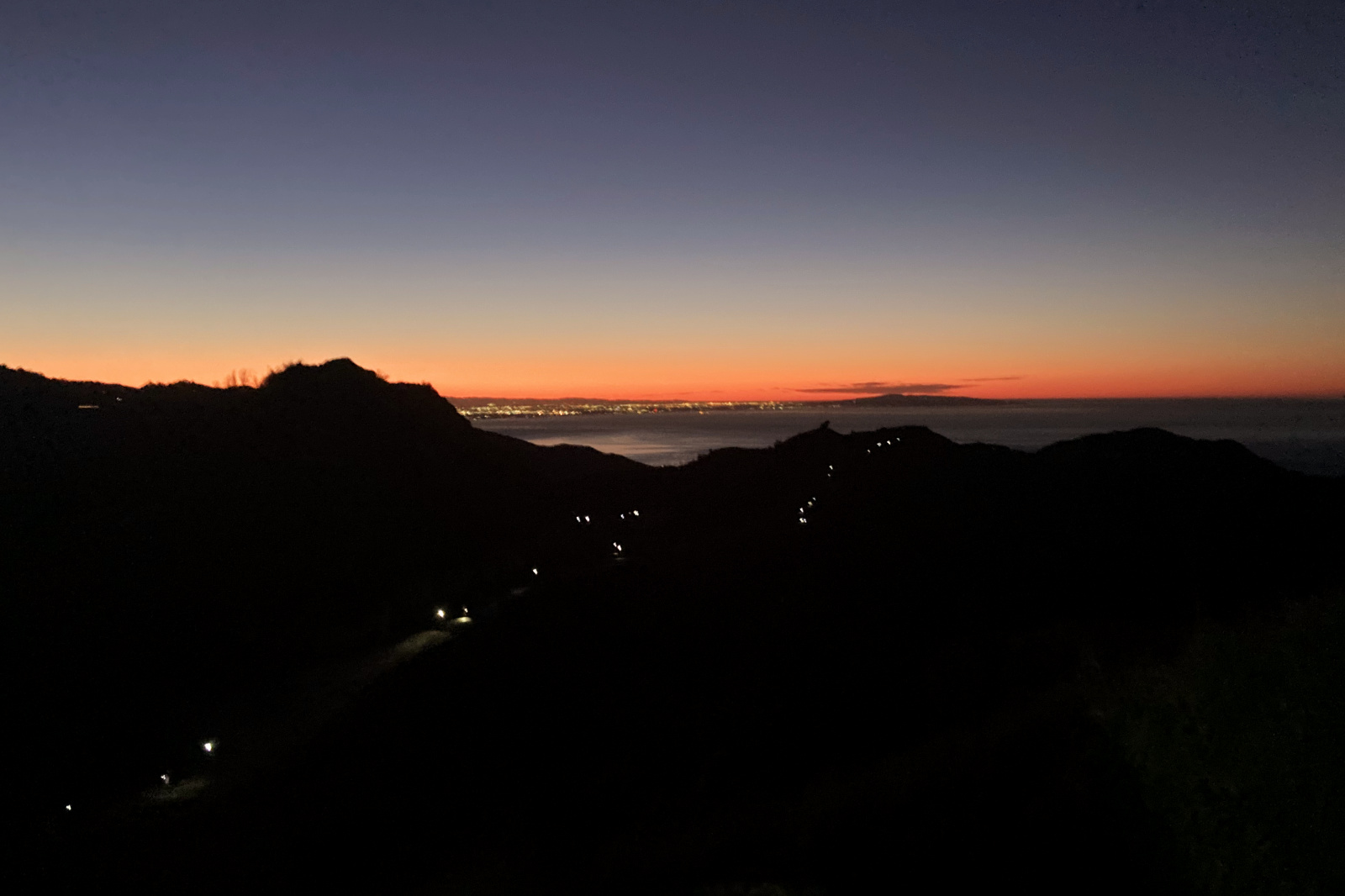After my DNF at the Squamish 50k, I was hungry to race again. My failure in Squamish was a combination of poor training decisions, challenging conditions, and some bad luck. Despite the disappointing result, however, my body was feeling strong and I was eager to apply that fitness to another race. I knew wanted to run something in early 2022, but the question was where.
In late October, Anne and I were preparing for our 6 month road trip of the USA. Our first stop was going to be in Wyoming, but we knew we would be staying with my parents in California over Christmas. After exploring the race possibilities in the SoCal area, I decided the Sean O’Brien 100k (SOB) would be the perfect event. It would bookend our time in California before we drove east towards Texas.
I’d first heard about SOB in early 2020 when Ella flew down from Seattle to run. It was a golden ticket race for Western States at that time which meant it attracted some talented runners. Crew aren’t permitted on most of the course, so I drove up to Malibu State Park to cheer her on at the finish line and drive her home after the race. Hearing her stories from the day planted a seed in the back of my mind. It sounded like a great event.
The SOB course isn’t very technical (mostly dirt roads and easy trail) but it includes an ammple ~4300+ meters (~14,000 ft) of vertical gain. The cut offs are also very tight, maxing out at 16 hours for the whole event. If you hit trouble early on, you risk having to drop down to the 50 mile race which means a DNF and no Western States 100 qualifier. The odds of getting into the WS100 are probably less than 1% at this point, but I’ve decided that I’m going to enter the lottery every year on principle until I get in. Getting the finish at SOB means I don’t have to worry about getting a qualifier for the rest of the year.
My biggest concern heading into the race was the heat. Even in the winter, the SoCal sun can be relentless. It’s not so bad if you’re used to it, but Anne and I would be coming from a cold and rainy fall in Whistler, BC and an early winter in Wyoming where it snowed our first weekend in town. There’s very little shade on the SOB course, so even temperatures in the 70s were going to feel warm. Plus, heat has a tendency to upset my stomach. I learned that the hard way at the Avalon 50M in 2017, the last time I raced in California.
Over December and January in California, I made an effort to run during the hottest time of the day. My mileage was on the low end - my biggest week was only 50 miles — but I’d managed to incorporate a some decent vertical, interval workouts and I’d been doing CrossFit with Anne a couple time a week. By the final week before the race, I was nervous but confident I could finish. Unfortunately, my left flute had suddenly tightened up so I hit it hard with a lacrosse ball and a foam roller for a few days and I crossed my fingers it would loosen up by race weekend.
In planning for the course, I used my WAM 110k spreadsheet from 2019 as a template and entered all the aid station and vertical gain data. I felt rusty. Even though I’d run Squamish only a few months ago, being a 50k, the race didn’t require any logistics. I ran with two handhelds and stashed gels at the halfway point. That was more or less it. SOB required a little more planning as I wouldn’t have a crew and I’d absolutely need to stay ahead of my hydration and fuel intake if I wanted to succeed.
The night before the race, I packed everything up and loaded up the van. I should have prepared my drop bags the days earlier, but I’d instead procrastinated and left it to the last moment. I scrambled to count calories and get all my gear organized. I was stressed, but Anne was kind and supportive and helped me run through my race check list. SOB isn’t very spectator friendly so we agreed that I’d be doing the race by myself. I’d normally have loved some crew support, but on this occasion I was perfectly fine with going solo. I just wanted to run.
It was almost 10pm when I finally left the house and I still had an hour long drive ahead of me. So much for getting to bed early. I drove up in the van towards Malibu. I was aiming for a spot I’d found on iOverlander at a dog park in Calabasas, only 5 minutes from the race start. Fortunately the drive was painless and the park was vacant when I arrived just after 11pm. I quickly set up my bed and went to sleep, dreading my 3:45am alarm. I tossed and turned before finally falling asleep around midnight.
Race Day
It was surprisingly cold when I woke up. I wanted to stay bundled up in my sleeping bag, but didn’t dare hit snooze. Instead I turned on the propane heater and got dressed for the day. I drove over to Malibu State Park, greeted the friendly volunteers manning the entrance and parked. I threw on a puffy jacket and walked over to the registration tent, again shocked at how cold it was. It must have been just above freezing. I checked in with the organizers, dropped off my drop bags, then headed back to the warmth of the van.
At 4:45am, 15 minutes to race start, I walked over to the starting corral, still wearing a puffy over my running vest. Kiera Henniger, the race director, gave a brief pre-race talk and informed us that there had been a reroute due to a rock slide. One of the aid stations had moved location and we would be losing a couple of miles from the overall length. I didn’t fully understand the implications for my race plan, but it sounded fairly minor.
The starting area was sparse. I wondered if people were sheltering somewhere warm until the last possible moment or if there simply weren’t many runners this year. While shivering in the cold, I suddenly realized Jeff Browning was standing in front of me. I’ve always liked “Bronco Billy” and looked forward to seeing him out on the course. A few minutes later, we were off.
I started near the front but didn’t attempt to hold my position. I knew most of the first big ascent was on a wide road so there was little concern about being stuck behind a large pack of runners. I ran comfortably, but my hands were freezing. To make matters worse, one of my water bottles was leaking. Cold water steadily trickled down my fingers, numbing them in the process. To compensate, I held both of my water bottles with one hand and stuffed the other into the warmth of my jacket pocket, then alternated hands every few minutes. After a completing the first small climb and descent, we reached the creek crossing which was flowing much faster than it had been during my training run a couple weeks prior. Now both my hands and feet were wet and cold.
I’d set a goal time of 1h20 to reach the first aid station. It was the 10km mark, right before you drop into the first valley. It was tempting to push hard to take advantage of the cool air, but but knew I’d need to take it easy to avoid a blow-up later. Fortunately I had warmed up enough to take off my jacket and my limbs were no longer as cold.
Halfway up the climb I fell in with a guy named Luis. We could see the ocean and the early city lights down below. Luis cracked jokes while we tried to photographed the sunrise. We reached the top about 5 minutes behind my goal time, but I was happy with the pace. I topped up my bottles and grabbed a couple snacks from the aid station and continued on.
The second section is fairly runnable but has a deceptive amount of vertical gain. It undulates with no majors ups or downs. By 7am, the sun had risen and the ambient temperate was already getting warmer. I pushed ahead of Luis and fell in with a group of guys going a similar pace. We leapfrogged each other, choosing to run and walk at different times, trying to get into a rhythm.
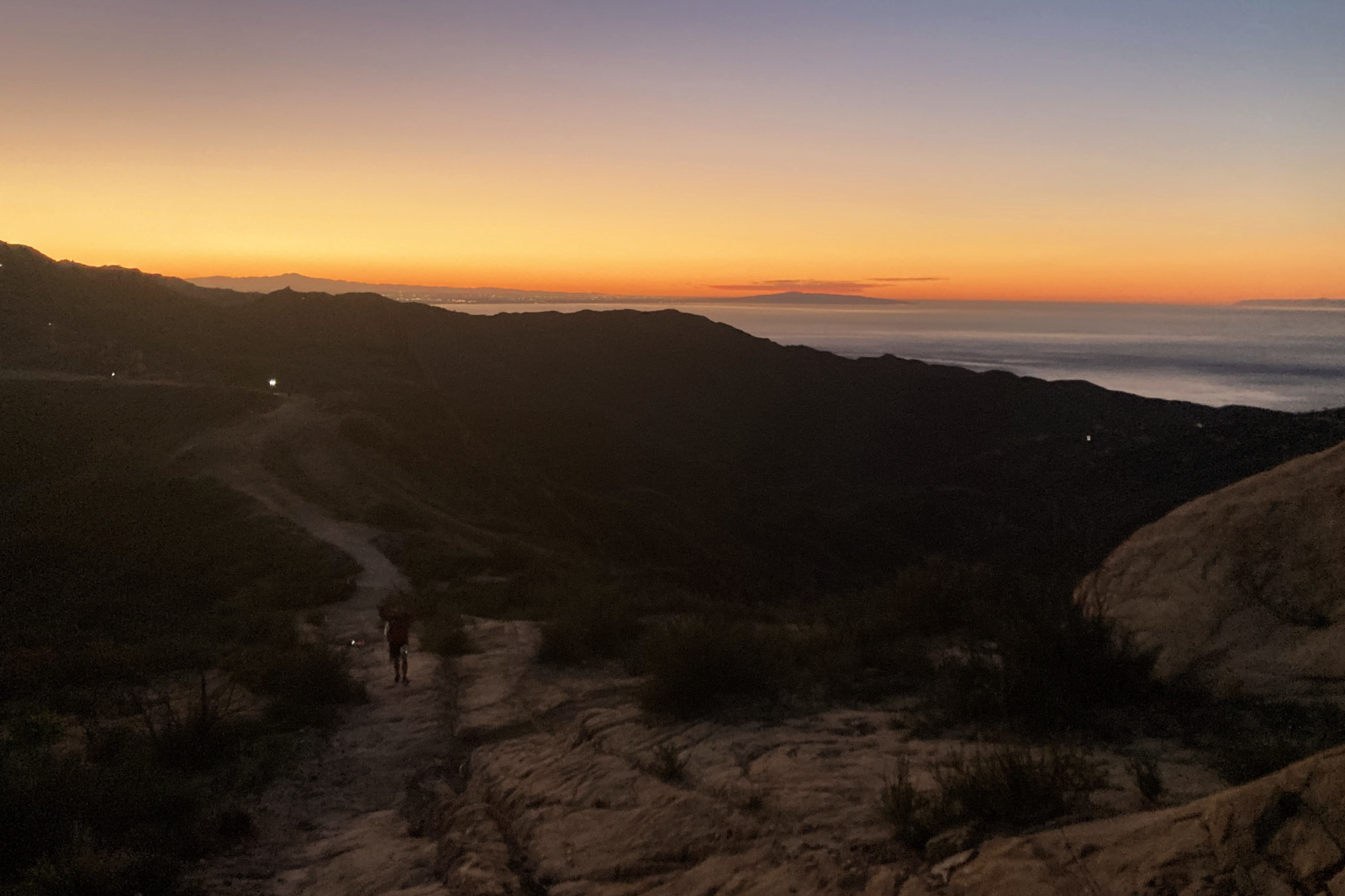
Sunrise in Malibu Creek state park
I arrived at the Kanan Road aid station at 21km feeling good. My first drop bag was here so I reloaded my race food, ate a couple mini donuts I’d stashed, and filled up my bottles. As I left, I asked one of the aid station crew how far until the next one and he said it was only a few miles. This didn’t make sense until I clicked that this was probably where the reroute came into effect. I tried to do some mental math in my head to see how this would affect my splits. I didn’t have it entirely figured out, but I wasn’t too concerned.
Less than half an hour later, I was at the Zuma Ridge aid station. I grabbed a snack and pressed on. From what I understood, we would be descending to Bonsall Drive and then returning to this aid station on the same road instead of coming up the ridge on the other side of the valley.
I hiked steadily up a road to towards the real Zuma Ridge when I noticed Luis wasn’t far behind me. I waited for him at the top of the ridge, where we were treated to a great view of the ocean. We fell in line together and started chatting as we began the long descent down to Bonsall. Being an L.A. native, Luis had run this race many times before and knew the trails well. He pointed out exactly where the course normally goes and shared with me some helpful tips about the back half of the course.
As we ran, I recalled Stringbean’s suggestion to take it easy and save my quads on the long descents. Fortunately Luis had the same strategy so we stuck together the whole way down. We chatted about ultras, Covid, and everything in between. As we got closer to the bottom, we started to see the lead pack pushing up the hill. I didn’t recognize the leader but Jeff Browning and Jesse Haynes weren’t far behind. I counted the runners ahead of me. I was in 15th and happy with the position.
The Bonsall Drive aid station was buzzing. I filled up on everything and grabbed a Skratch drink from my drop bag to fill one of my handhelds. I forced myself to eat some more chips and salty foods. The crew were helpful and supportive and seemed to be having a great time. Many of them, I learned, had run the race in prior years and were eager to assist with anything. It was tempting to hang out and enjoy the vibe, but I knew I needed to head out.
Luis and a few of other runners hung out at the aid station a bit longer, so I started on the climb alone. I was feeling really good and pulled out my phone to text Anne with an update. “4.5 hours in. On A goal pace. Feeling good but getting warm.” A few other friends had messaged me while I’d been running, so I gave them a brief update before putting my phone away.
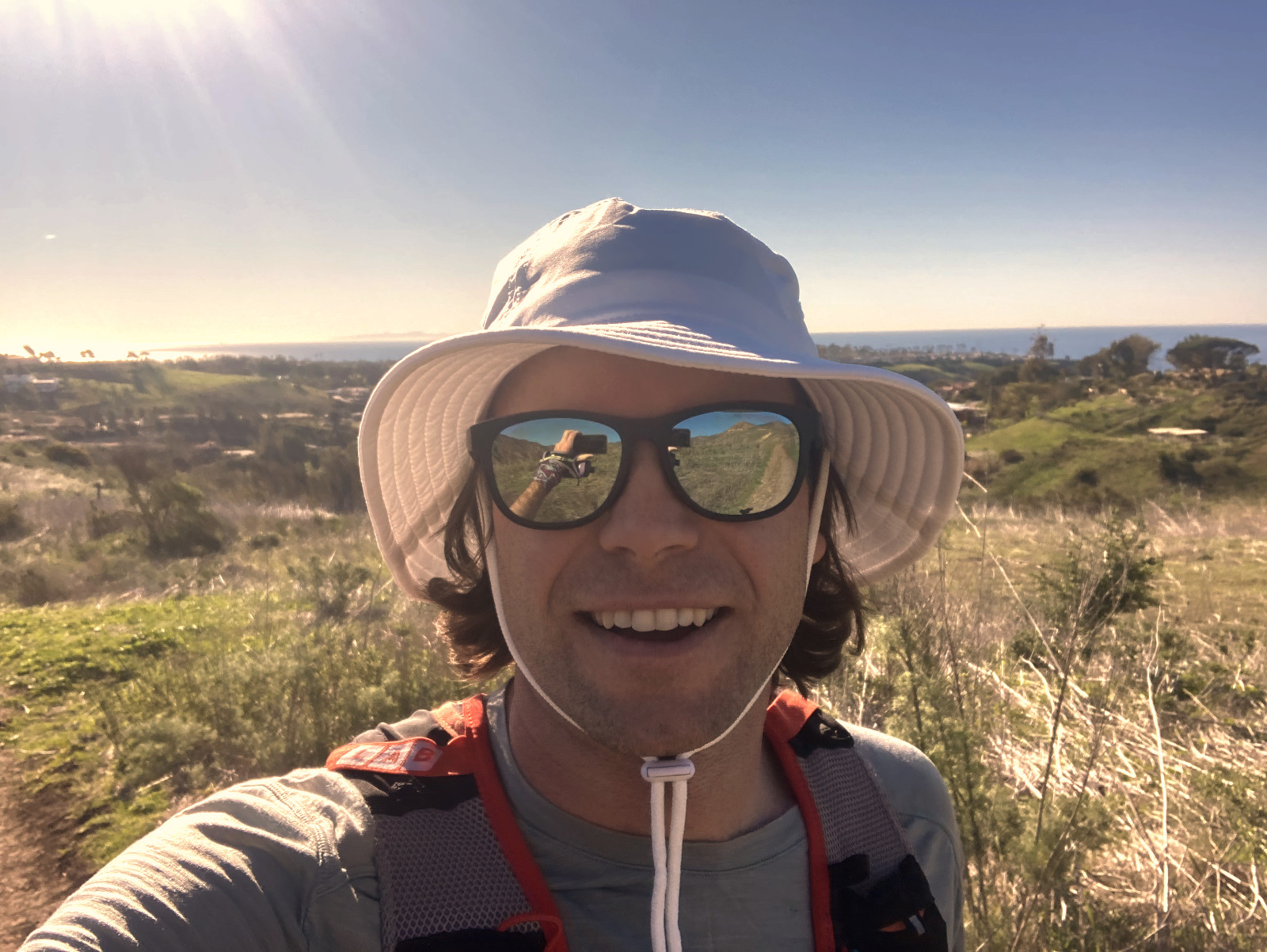
Quick selfie during the big climb back to Zuma Ridge
The air was still cool, but the sun was shining and it was getting warm. I was pleased with my decision to wear a bucket hat. To keep my legs feeling fresh, I alternated walking with spurts of running whenever the grade flattened slightly. I couldn’t see Luis behind me, but a guy in an orange shirt bobbed into view from time to time, maintaining a steady pace behind me.
After an hour, climb was starting to drag on, so I put on some music to stay focused. I’d foolishly put the Scratch drink into my leaking water bottle which meant my right hand was by now covered in a coating of sugary water. Out of nowhere, two guys came running past me at an impressive pace. As they passed, they quickly assured me that they weren’t in the race. We chatted for a while and talking with them broke the monotony nicely.
About a third of the way from the top, my back started to ache. I was ready for the climb to end. Runners in the 50 miler started to appear going the other way, and everyone was encouraging and supportive. My pace was slowing, but after a few false summits, I finally reached the top of Zuma Ridge and began descending back down to the aid station. When I finally arrived, I was feeling tired and my legs were stiff. I ate a cold quesadilla and rested for a few mintes while two runners I didn’t recognize pushed ahead of me. I’d slowed down considerably. We were 50k in and I needed a second wind.
The Second Half
Half an hour later I was back at Kanan Road, around the 55km mark. An attendant at the aid station helped me find my drop bag and filled up my water bottles. He’d run the race before and passed on some advice, particularly about the heat. He could tell I was a little dehydrated and suggested I take extra water. I drank as much as I could from my stashed Scratch drink. As I was leaving, another crew member convinced me to stop and eat a freshly made PB&J sandwich before I took off again. I was convinced and grateful for the prodding. The volunteers at this race were amazing.
The next section was rough. While it had been easy running in the morning, we were now in fully exposed, hot sun. I felt dehydrated and light headed. I drank as much water as a I could and eased up on the pace. The worst of it passed within 20 minutes, but it was concerning. I needed fluids and salt. I wasn’t running any of the hills, but I was moving steadily on the flats and downs. I managed to maintained my distance behind the runner who’d passed me at Zuma which I was happy about.
When I finally made it back up to the Coral Canyon aid station, I felt considerably better. I drank as much water as I could then texted Anne. “Just left 61k aid station in 8:05.” I thanked the crew and pressed on. The next section starts with a brief climb along a ridge before descending to Bulldog Road. It’s another out-and-back, so every step down has to be repeated going the other way. It’s shorter than the Zuma/Bonsall/Zuma section, but on tired legs, I knew it was going to be tough.
One of the lead women was behind me and caught me at the beginning of the descent. I had probably dropped to 18th or 19th at this point, but I wasn’t all that bothered about maintain position. Today was about completion, not racing.
The road down to Bulldog was easy running, but my stomach didn’t feel good. A third of the way down, we saw the lead pack coming back up the hill. Jesse was now leading and Jeff was a few minutes behind him. I gave them a supportive cheer as they passed (which I frankly needed far more than they did).
The descent dragged on for ages and my stomach got progressively worse. The best distraction was linking with the guy in the orange hat who I would later learn was named Dylan. He was having a similar sort of day as me and we commiserated over our ups and downs. I think for many runners (including me), SOB was a return to ultrarunning after a long Covid haitus.
I was in rough shape by the time we reached the bottom. We were on a sandy trail that follows a river. My stomach was in knots and begging for me to slow down, so I stopped to walk while Dylan went ahead of me. We were close to the Malibu Creek campground at this point so day hikers started to appear. I smiled and waved, pretending to be having a good time.
At my lowest point, I entertained the idea of dropping at the Bulldog aid station. I’d managed to start running again, but I couldn’t fathom climbing all the way back to the top of the ridge. A cycle of negative thoughts started to swirl around in my head and I regretted not training harder. I was frustrated that I wasn’t performing better and at risk of another DNF. Was I no longer the runner I thought I was?
With the Bulldog aid station moved back about a mile, I didn’t know where it would be. I was fading quiclly and prayed it would come soon. Just when I was about to stop and walk, it came into view and I pushed myself to run it in with whatever energy I could muster. It was small win, but one I needed. I needed to mentally reset and get out of the negative head space I was in.
There were a surprising number of runners hanging around the aid station. It became immediately obvious that I wasn’t the only one struggling with the heat. I found a spot to sit in the shade and the aid station crew immediately asked me what I needed. I was offered coke, watermelon, and ice to cool my neck. The woman helping me seems to anticipate everything I needed before I could ask. So professional.
At some point, I texted Anne, “I’m at 72km. 9h30. Little behind but more or less on pace. Stomach isn’t happy so taking a break.” I drank as much of the Skratch drink from my drop bag as I could handle, then gathered my things. I thanked the amazing crew and headed out. Before I could really process what was happening, I was running again and feeling much better. The thought of dropping out had vanished and I knew I was going to finish, regardless of how long it took. I caught up to Dylan and we started chatting again. We tried to estimate how long it would take us to finish. I estimated three hours; he thought we could do it in less.
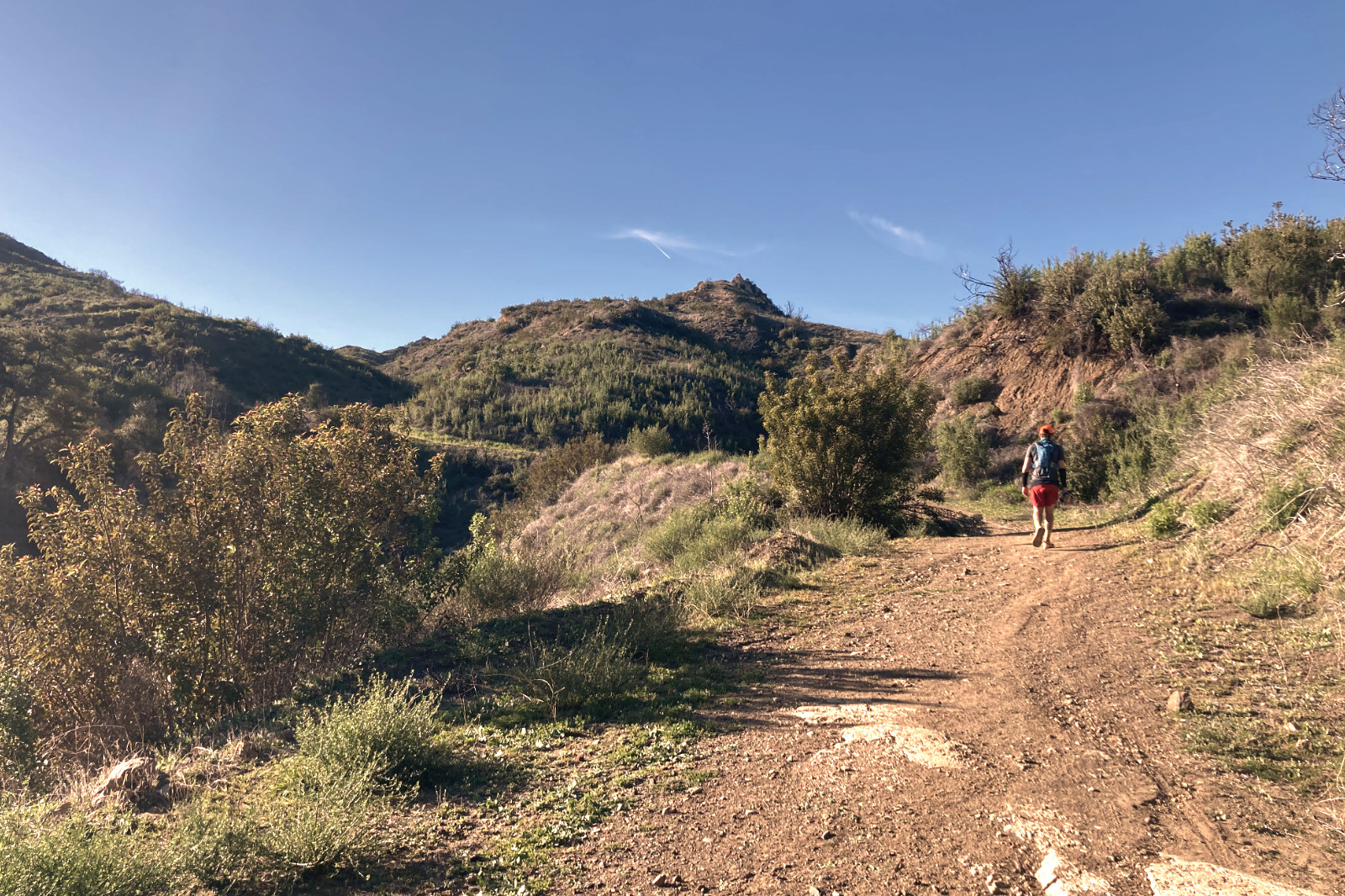
Final climb back to up to Coral Canyon
The climb started well, but half way up, my stomach started to turn again. It was manageable if I went slow which meant a couple more runners passed us on the way up. Despite our pace, whenever I looked back at the valley below, I marvelled at how far we had travelled.
It took us about two hours to make back to the Coral Canyon aid station. I was 30 minutes behind my goal time — which, when adjusted for the reroute, was more like an hour — but I was relieved to have finished the climb. My stomach was in knots again but a friendly woman on the crew gave me some coke and words of encouragement which helped. I saw Dylan leave before me, so I finished my coke and set off behind him. We still had some light left in the day, but the sun was setting quickly. My new goal became to finish without having to turn on my headlamp.
I had forgotten how many hills there along the ridge before the final descent. The views were beautiful but I felt terrible. Dylan and I leapfrogged from time to time. Despite our hobbled gaits, we complimented each other about how “fresh” we looked. At one point, he started slowing down and I pulled ahead of him with an unexpected burst of energy.
30 minutes later, I was descending down the main road and my second wind started to fade. A runner came up behind me made a cheerful joke as he came into view. It was Luis! He pulled up next to me and we exchanged a few words. He was looking strong. I tried to keep up with him, but despite my best efforts, he left me behind.
When I got to the bottom of the road, two more runners has passed me there was only a glimmer of sunlight left. I came across a 50 mile runner who was lost. He couldn’t find the turn off for the creek crossing, so I told him to follow me and guided him down the spur trail that takes you down to the water. I was about to grab the rope and cross the creek, when I decided I should probably put on my headlamp for safety. I turned it on and accepted I would be finishing in the dark.
With wet feet, I passed a few more 50 mile runners on the way back to the final hill. The climb itself was steeper than I remembered coming down it 13 hours earlier. I was tired and ready to be done, but it dragged on and on and on. I marched as fast as I could, stopping a few times to summon whatever scraps of energy I still had. When I eventually reached the top of the climb, I used the little momentum I had to cruise down the trail toward the Malibu campground.
As I finished the final descent and joined the main road again, my mood started to shift. I had this! My first race finish in almost two and a half years was in the bag; I just needed to reel it in.
I pulled up to the gate and turned towards the finish line as a few bundled up supporters cheered me in. I was grateful. Having been a supporter two years prior, I knew how cold it was to sit there. I smiled as I crossed the finish line and stopped my watch: 13 hours, 20 minutes. Done.
Post Race
I fumbled around in the dark looking for my drop bags. I was starting to cool down and needed a jacket. I was still warm, but I knew I’d soon be freezing if I stood around for too long. I grabbed some food from the BBQ area and looked around for some familiar faces when I saw Dylan come across the finish line. Some friends of his were there to see him in. At a convenient moment, I stopped by to congratulated him and we chatted for short while, recounting some of the the day’s highs and lows. When I said goodbye, I walked back to the van to change and rest before driving back down to Orange County. I was exhausted.
Once I’d changed into some fresh clothes, I took a moment to reflect on the day. Of all emotions, I was most overcome with relief. A lot could have gone wrong during the day and a DNF was a real possibility. My lack of training definitely showed and my nutrition game was far from dialed in. Still, I was proud of some late stage problem solving and my mental turnround at the Bulldog aid station. Even if I didn’t get the result I wanted, it was still a great day. I may have lost the ultrarunning spark over the previous two years, but the fire was now burning again.
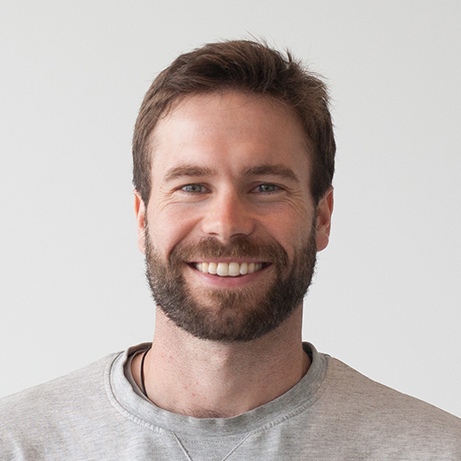
Ross Noble is a software developer, ultrarunner, podcaster and former van-dweller with a passion for the outdoors. He writes about running, cinema and anything else that interest him.
Montreal, QC
